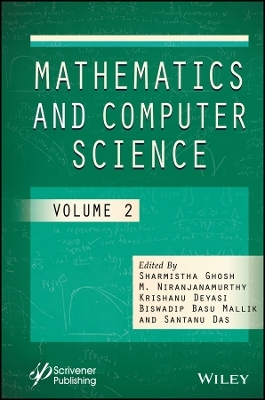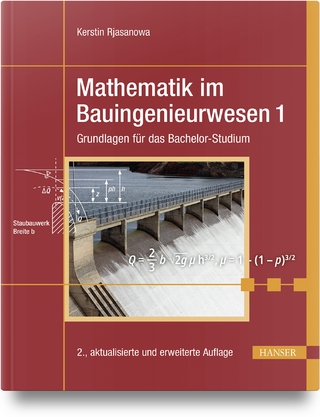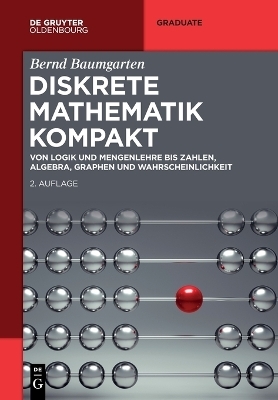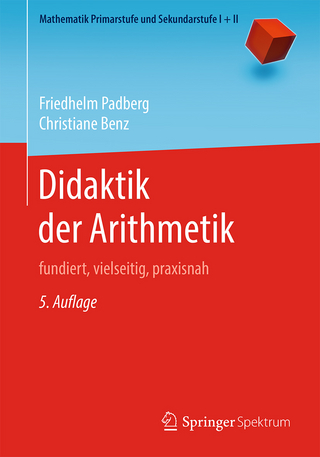
Mathematics and Computer Science, Volume 2
Wiley-Scrivener (Verlag)
978-1-119-89632-6 (ISBN)
This second volume in a new series from Wiley-Scrivener is the first of its kind to present scientific and technological innovations by leading academicians, eminent researchers, and experts around the world in the areas of mathematical sciences and computing. Building on what was presented in volume one, the chapters focus on more advanced topics in computer science, mathematics, and where the two intersect to create value for end users through practical applications.
The chapters herein cover scientific advancements across a diversified spectrum that includes differential as well as integral equations with applications, computational fluid dynamics, nanofluids, network theory and optimization, control theory, machine learning and artificial intelligence, big data analytics, Internet of Things, cryptography, fuzzy automata, statistics, and many more. Readers of this book will get access to diverse ideas and innovations in the field of computing together with its growing interactions in various fields of mathematics. Whether for the engineer, scientist, student, academic, or other industry professional, this is a must-have for any library.
Sharmistha Ghosh, PhD, is a professor at the Institute of Engineering and Management, India. She received her doctorate in mathematics from the Indian Institute of Technology, India. Her major field of study includes fuzzy and vague databases as well as computational fluid dynamics, and she has published several papers in scientific journals. She is also the editor of several scientific journals and works as a reviewer of journals as well as doctoral theses in India as well abroad. M. Niranjanamurthy, PhD, is an assistant professor in the Department of Computer Applications, M S Ramaiah Institute of Technology, Bangalore, Karnataka. He earned his PhD in computer science at JJTU, Rajasthan, India. He has over 11 years of teaching experience and two years of industry experience as a software engineer. He has published several books, and he is working on numerous books for Scrivener Publishing. He has published over 60 papers for scholarly journals and conferences, and he is working as a reviewer in 22 scientific journals. He also has numerous awards to his credit. Krishanu Deyasi is an associate professor in the Department of Basic Sciences and Humanities at the Institute of Engineering and Management, India. He earned his PhD from the Indian Institute of Science Education and Research, and he has postdoctoral experience from The Institute of Mathematical Sciences, India. He has written three books and has published papers in scientific journals. He is also an editor for several scientific journals. Biswadip Basu Mallik is a senior assistant professor of mathematics in the Department of Basic Sciences and Humanities at the Institute of Engineering and Management, India. He has been involved in teaching and research for more than 21 years and has published several research papers in various scientific journals along with book chapters with various publishers. He has authored five books and has five patents to his credit. He is a managing editor of the Journal of Mathematical Sciences & Computational Mathematics and is an editorial board member and reviewer for several scientific journals. Santanu Das is as an assistant professor in the Department of Basic Sciences and Humanities at the Institute of Engineering and Management, India. He completed his undergraduate degree from and is pursuing his doctorate from Jadavpur University.
Preface xvii
1 A Comprehensive Review on Text Classification and Text Mining Techniques Using Spam Dataset Detection 1
Tamannas Siddiqui and Abdullah Yahya Abdullah Amer
1.1 Introduction 2
1.2 Text Mining Techniques 3
1.2.1 Data Mining 3
1.2.2 Information Retrieval 4
1.2.3 Natural Language Processing (NLP) 5
1.2.4 Information Extraction 5
1.2.5 Text Summarization 6
1.2.6 Text Categorization 7
1.2.7 Clustering 7
1.2.8 Information Visualization 7
1.2.9 Question Answer 8
1.3 Dataset and Preprocessing Steps 9
1.3.1 Text Preprocess 9
1.4 Feature Extraction 9
1.4.1 Term Frequency – Inverse Document Frequency 10
1.4.2 Bag of Words (BoW) 10
1.5 Supervised Machine Learning Classification 11
1.6 Evaluation 11
1.7 Experimentation and Discussion Results for Spam Detection Data 11
1.8 Text Mining Applications 13
1.9 Text Classification Support 13
1.9.1 Health 13
1.9.2 Business and Marketing 14
1.9.3 Law 14
1.10 Conclusions 14
References 15
2 Study of Lidar Signals of the Atmospheric Boundary Layer Using Statistical Technique 19
Kamana Mishra and Bhavani Kumar Yellapragada
2.1 Introduction 19
2.2 Methodology 21
2.2.1 A Statistical Approach to Determine the CBLH 21
2.2.2 A Statistical Approach to Determine the Best Fit Distribution to the Backscatter Signals of the Lidar Dataset 22
2.3 Mathematical Background of Method 23
2.4 Example and Result 24
2.5 Conclusion and Future Scope 27
Acknowledgement 28
References 28
Annexure 30
3 Optimal Personalized Therapies in Colon Cancer Induced Immune Response using a Fokker-Planck Framework 33
Souvik Roy and Suvra Pal
3.1 Introduction 33
3.2 The Control Framework Based on Fokker-Planck Equations 35
3.3 Theoretical Results 39
3.4 Numerical Schemes 41
3.5 Results 43
3.6 Conclusion 44
Acknowledgments 45
References 45
4 Detection and Classification of Leaf Blast Disease using Decision Tree Algorithm in Rice Crop 49
Sarvesh Vishwakarma and Bhavna Chilwal
4.1 Introduction 49
4.2 Proposed Methodology 51
4.3 Result Analysis 52
4.4 Conclusion 55
4.5 Future Work 55
References 56
5 Novel Hybrid Optimal Deep Network and Optimization Approach for Human Face Emotion Recognition 59
J. Seetha, M. Ayyadurai and M. Mary Victoria Florence
5.1 Introduction 60
5.2 Related Work 61
5.3 System Model and Problem Statement 62
5.4 Proposed Model 63
5.4.1 Preprocessing Stage 64
5.4.2 Knowledge Based Face Detection 64
5.4.3 Image Resizing 64
5.4.4 Feature Extraction 64
5.5 Proposed HDC-GEN Classification 65
5.6 Result and Discussion 68
5.6.1 Performance Metrics Evaluation 69
5.6.2 Comparative Analysis 70
5.7 Conclusion 74
References 74
6 An Application of Information Technology in Adaptive Leadership of Ministry of Ayush During Pandemic of Covid 19: A Case Study 77
Vikram Singh, Shikha Kapoor and Sandeep Kumar Gupta
6.1 Introduction 77
6.2 Ministry of AYUSH 78
6.3 Leadership Principles and Practices by Ministry of AYUSH During Covid- 19 79
6.4 Effective Communication 79
6.5 Sharing of Resources 80
6.6 Shared Decision Making 81
6.7 Training of Manpower 81
6.8 Use of IT Platform 81
6.9 Finding Opportunities for R&D During the Crisis 83
6.10 Collaborating with Stakeholders for International Day of Yoga (IDY) 84
6.11 Providing Hope When Nothing Seemed to be Working 87
6.12 Leveraging Old Knowledge 87
6.13 Conclusion 88
References 88
7 Encoder-Decoder Models for Protein Secondary Structure Prediction 91
Ashish Kumar Sharma and Rajeev Srivastava
7.1 Introduction 91
7.2 Literature Review 93
7.3 Experimental Work 93
7.3.1 Data Set 93
7.3.2 Proposed Methodology 94
7.3.3 Data Preprocessing 94
7.3.4 Long Short Term Memory 94
7.4 Results and Discussion 96
7.5 Conclusion 97
References 98
8 Hesitancy, Awareness, and Vaccination: A Computational Analysis on Complex Networks 101
Dibyajyoti Mallick, Aniruddha Ray, Ankita Das and Sayantari Ghosh
8.1 Introduction 101
8.2 Model Formulation 103
8.3 Model Analysis on Complex Network 106
8.3.1 Effect of Vaccination Rate 107
8.3.2 Effect of Negative Rumors 108
8.3.3 Effect of Positive Peer Influence 108
8.4 Conclusions and Perspectives 111
References 112
9 Propagation of Seismic Waves in Porous Thermoelastic Semi-Infinite Space with Impedance Boundary Conditions 115
Annu Rani and Dinesh Kumar Madan
9.1 Introduction 115
9.2 Basic Equations 116
9.3 Problem Formulation 118
9.4 Reflection at the Free Surface 121
9.4.1 Boundary Conditions 124
9.4.2 Energy Ratios 126
9.5 Numerical Results and Discussion 127
9.6 Conclusion 133
References 134
10 IoT Based Ensemble Predictive Techniques to Determine the Student Observing Analysis through E-Learning 137
Rufia Thaseen I., S. Shahar Banu and Sudha Rajesh
10.1 Introduction 138
10.2 Review of Literature 140
10.2.1 Objectives of the Study 142
10.3 Methodology 142
10.4 Analysis and Interpretation 143
10.5 Findings and Conclusion 147
References 148
11 Modelling and Analysis of a Congestion Dependent Queue with Bernoulli Scheduled Vacation Interruption and Client Impatience 151
K. Jyothsna and P. Vijaya Kumar
11.1 Introduction 152
11.2 Model Overview 154
11.3 Model Analysis 155
11.3.1 Pre-Arrival Epoch Probabilities 157
11.3.2 Arbitrary Epoch Probabilities 162
11.4 Special Cases 163
11.5 Performance Metrics 163
11.6 Numerical Outcomes 164
11.7 Conclusion 169
References 169
12 Resource Allocation Determines Alternate Cell Fate in Bistable Genetic Switch 173
Priya Chakraborty and Sayantari Ghosh
12.1 Introduction 173
12.2 Model Formulation 176
12.3 Result Section 178
12.3.1 Pitchfork Bifurcation in Genetic Toggle 178
12.3.1.1 Resource Affinity Regulates the Symmetry of Pitchfork Bifurcation 178
12.3.1.2 Availability of Total mRNA Pool Regulates the Symmetry of Pitchfork Bifurcation 180
12.3.1.3 Total Resource Availability Regulates the Point of Bifurcation in the System 180
12.3.2 Saddle Node Bifurcation in Genetic Toggle 180
12.3.2.1 Resource Distribution Regulates the Point of Bifurcation in Toggle Switch 182
12.3.2.2 Region of Interest in Toggle Switch is Significantly Regulated by Resource Allocation 182
12.3.2.3 Total Resource Availability T Regulates Saddle Node Bifurcation Curve 183
12.4 Conclusion 183
Acknowledgement 184
References 184
13 A Hybrid Approach to Ontology Evaluation 187
Aastha Mishra and Preetvanti Singh
13.1 Introduction 187
13.2 Background 188
13.3 The Developed OntoEva Method 189
13.4 Ontology Selection for Epilepsy Disorder 190
13.4.1 Accuracy 191
13.4.2 Adaptability 191
13.4.3 Clarity 191
13.4.4 Completeness 192
13.4.5 Conciseness 192
13.4.6 Consistency 192
13.4.7 Organizational Fitness 192
13.5 Results 201
13.6 Comparison of Ontologies 201
13.7 Conclusion 202
References 203
14 Smart Health Care Waste Segregation and Safe Disposal 205
R.M. Bommi, Sami Venkata Sai Rajeev, Sarvepalli Navya, Veluru Sai Teja and Uppala Supriya
14.1 Introduction 206
14.2 Related Works 207
14.3 System Architecture 210
14.3.1 Wrapping 212
14.3.2 Incinerator 213
14.3.3 Conveyor Cleaning System 213
14.3.4 Circuit Diagram 213
14.3.5 Optimal Path Planning Algorithm for Waste Collection 214
14.4 Methodology 214
14.5 Mobile App 217
14.6 Conclusions and Future Works 218
Declarations 219
Availability of Data and Materials 219
Competing Interests 219
Author’s Contribution 219
References 219
15 Investigation of Viscoelastic Magnetohydrodynamics (MHD) Flow Over an Expanded Lamina Surrounded in a Permeable Media 223
Hiranmoy Mondal, Arindam Sarkar and Raj Nandkeolyar
15.1 Introduction 223
15.1.1 Literature Review 223
15.1.2 Nomenclature 224
15.2 Formulation of the Problem 226
15.2.1 Analytical Solution 227
15.2.2 Numerical Methods (Spectral Quasi-Linearization Methods) 228
15.3 Result and Argument 230
15.4 Conclusion 235
References 236
16 Quickest Multi-Commodity Contraflow with Non-Symmetric Traversal Times 239
Shiva Prakash Gupta, Urmila Pyakurel and Tanka Nath Dhamala
16.1 Introduction 239
16.2 Preliminaries with Flow Models 242
16.2.1 Mathematical Model with Contraflow 242
16.3 QMCCF with Non-Symmetric Transit Times 244
16.3.1 Approximation Approach for the QMCCF 245
16.4 Conclusions 248
Acknowledgments 248
References 248
17 A Mathematical Representation for Deteriorating Goods with a Trapezoidal-Type Demand, Shortages and Time Dependent Holding Cost 251
Ruma Roy Chowdhury
17.1 Introduction 251
17.2 Assumptions and Notations 253
17.2.1 Assumptions 253
17.2.2 Notation 254
17.2.3 Decision Variables 255
17.3 Formulation and Solution 255
17.3.1 Case 1 i) 0 < ν < t 1 < t 2 < t 3 < T 255
17.3.2 Case 2 ii) 0 < t a < ν < t b < t c < T 257
17.3.3 Case 3 iii) 0 < t a < t b < ν < t c < T 259
17.4 Numerical Example 261
17.5 Discussion 261
17.6 Inference 262
References 262
18 An Amended Moth Flame Optimization Algorithm Based on Fibonacci Search Approach for Solving Engineering Design Problems 265
Saroj Kumar Sahoo and Apu Kumar Saha
18.1 Introduction 266
18.2 Classical MFO Algorithm 268
18.3 Proposed Method 270
18.4 Results and Discussions on IEEE CEC 2019
Benchmark Problems 273
18.5 Real-Life Applications 277
18.5.1 Optimal Gas Production Capacity Problem 277
18.5.2 Three-Bar Truss Design (TSD) Problem 277
18.6 Conclusion with Future Studies 278
References 279
19 Image Segmentation of Neuronal Cell with Ensemble Unet Architecture 283
Kirtan Kanani, Aditya K. Gupta, Ankit Kumar Nikum, Prashant Gupta and Dharmik Raval
19.1 Introduction 284
19.2 Methods 285
19.3 Dataset 285
19.4 Implementation Details 286
19.5 Evaluation Metrics 286
19.6 Result 286
19.7 Conclusion 289
References 289
20 Automorphisms of Some Non-Abelian p−Groups of Order p4 291
Muniya Sansanwal, Harsha Arora and Mahender Singh
20.1 Introduction 291
20.2 Categorization of p-Groups with Order p4 292
20.3 Number of Automorphisms of Some Non-Abelian Groups of Order p4 293
20.3.1 Computation of Automorphisms of Group G9 293
20.3.2 Computation of Automorphisms of Group G10 297
20.3.3 Computation of Automorphisms of G11 300
References 304
21 Viscoelastic Equation of p-Laplacian Hyperbolic Type with Logarithmic Source Term 305
Nazlı Irkıl and Erhan Pişkin
21.1 Introduction 305
21.2 Preliminaries 307
21.3 Global Existence Result 314
21.4 Blow Up Results of the Solution for Equation (21.1) 317
References 324
22 Flow Dynamics in Continuous-Time with Average Arc Capacities 327
Badri Prasad Pangeni and Tanka Nath Dhamala
22.1 Introduction 327
22.2 Literature Review 329
22.3 Failure in Extension of AP to AAP 329
22.4 Formulation 331
22.5 Conclusion 334
Acknowledgment 334
References 334
23 Analysis of a Multiserver System of Queue-Dependent Channel Using Genetic Algorithm 337
Anupama and Chandan Kumar
23.1 Introduction 337
23.2 Description of the Model 338
23.3 Notations 338
23.4 Steady State Equations 340
23.4.1 Performance Characteristics of the System 342
23.4.2 Queue Length Evaluations at Different Epochs 343
23.4.3 Leisure Period and Working Period Length 343
23.4.4 Cost of the System 343
23.5 Conclusions 347
References 347
24 An Approach to Ranking of Single Valued Neutrosophic Fuzzy Numbers Based on (α, β, γ) Cut Sets 349
Sunayana Saikia
24.1 Introduction 349
24.2 Definition and Representations 351
24.3 Proposed Method 355
24.4 Theorems 356
24.5 Numerical Examples 357
24.6 Conclusion 358
References 359
25 Performance Analysis of Database Models Based on Fuzzy and Vague Sets for Uncertain Query Processing 363
Sharmistha Ghosh and Surath Roy
25.1 Introduction 363
25.2 Basic Definitions 364
25.2.1 Fuzzy Set 365
25.2.2 Vague Set 365
25.2.3 Similarity Measure 365
25.3 Algorithm to Generate Membership Values 366
25.4 Real Life Applications 368
25.5 Conclusion 382
References 382
26 Estimating Error of Signals by Product Means (N, pn,qn) (C, 2) of the Fourier Series in a W(Lr , ξ (t))(r ≥ 1) Class 385
Pankaj Tiwari and Aradhana Dutt Jauhari
26.1 Introduction 385
26.1.1 Definition 1 386
26.1.2 Definition 2 386
26.1.3 Definition 3 386
26.1.4 Definition 4 387
26.1.5 Remark 1 387
26.2 Known Result 388
26.2.1 Theorem 1 388
26.3 Main Theorem 389
26.3.1 Theorem 2 389
26.4 Some Auxiliary Results 390
26.4.1 Lemma- 1 390
26.4.2 Lemma- 2 390
26.5 Theorem’s Proof 391
26.6 Applications 394
26.6.1 Cor. 1 394
26.6.2 Cor. 2 394
26.7 Conclusion 394
Acknowledgement 395
References 395
About the Editors 397
Index 401
| Erscheinungsdatum | 03.08.2023 |
|---|---|
| Sprache | englisch |
| Gewicht | 830 g |
| Themenwelt | Mathematik / Informatik ► Mathematik |
| Technik ► Elektrotechnik / Energietechnik | |
| ISBN-10 | 1-119-89632-0 / 1119896320 |
| ISBN-13 | 978-1-119-89632-6 / 9781119896326 |
| Zustand | Neuware |
| Haben Sie eine Frage zum Produkt? |
aus dem Bereich


